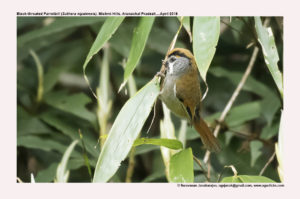
Black-throated Parrotbill Suthora nipalensis
Etymology:
- Suthora :Nepalese name Suthora-Parrotbill.
- Nipalensis : From Nepal
Vernacular Names : Cachar: Dao mougashakashiba, Nepal: Suthora
Distribution in India: Resident of Himalayas and North east India.
Description: Size of 11·5 cm; male wt. is 6–7 g and female wt. is 5·5 g. The nominate race has brownish mid-grey crown and nape, sometimes paler on forehead, broad blackish lateral crown stripe from bill base to above rear ear-coverts, which is broadest above and behind eye, white lores, orbital area, short supercilium, cheek and moustachial/malar area. It has a slaty mid-grey rear supercilium, remainder of ear-coverts are faintly buff-tinged and area behind ear-coverts; mantle, back and scapulars are rufescent mid-brown, grading to rufous on uppertail-coverts. The upperwing-coverts are as mantle, but alula mostly greyish. The primary coverts are blackish; secondaries and tertials are grey-black, broadly edged white on inside, becoming rich buff on inner edges of tertials, and outer edges of secondaries rufous and narrowly tipped white. The primaries are also grey-black, P10 with white outer fringe extending about half-way to tip, P9 with white fringe extending almost to tip, P6-P8 with extremely narrow white fringe which turns rufous-buff at base, and inner primaries gradually showing more rufous extending along outer fringe from base, then blackish, with white restricted to terminal half of fringe, inner edges of primaries are also white. The tail quite strongly graduated, warm-tinged mid-brown on upperside, feathers with mostly rufous outer webs and all tipped blackish-brown; center of upper throat blackish with rufous-buff feather tips that appears mottled, but shows roughly an inverted blackish “V” from chin to upper side of throat center, rufous-buff lower throat center and underparts, with white center of lower breast and belly. The iris is brown to reddish-brown; bill is horn-coloured to pinkish-yellow, blackish with paler base of lower mandible. The legs are pinkish-grey to greenish-grey, slate-grey or pale horn-coloured. Both the sexes are alike. The juvenile is similar to adult.
Habitat: It is found in bamboo and undergrowth in broadleaf evergreen, oak, rhododendron and mixed deciduous forest. It is found from 1525–3300 m.
Food habits : It eats small insects, bits of bamboo, bamboo buds, and grass seeds. It is found in parties of 3–40 or more individuals, often in association with other species, including babblers in bird waves. Moves very fast; bouts of activity are interspersed with short periods when may forage more slowly and methodically or sit huddled together side by side. It pries away at bases of bamboo leaves to obtain food.
Breeding habits: They breed in Mar–Jul in India. The nest is a tiny, neat and compact cup-shaped structure made of bamboo leaves and fine grasses, coated on outside with cobwebs, lined with very fine grass stems and root hairs, above the ground and fixed in cluster of twigs protruding from bamboo node or placed in thick bush or tangle of creepers. They lay a clutch of 2–4 eggs.